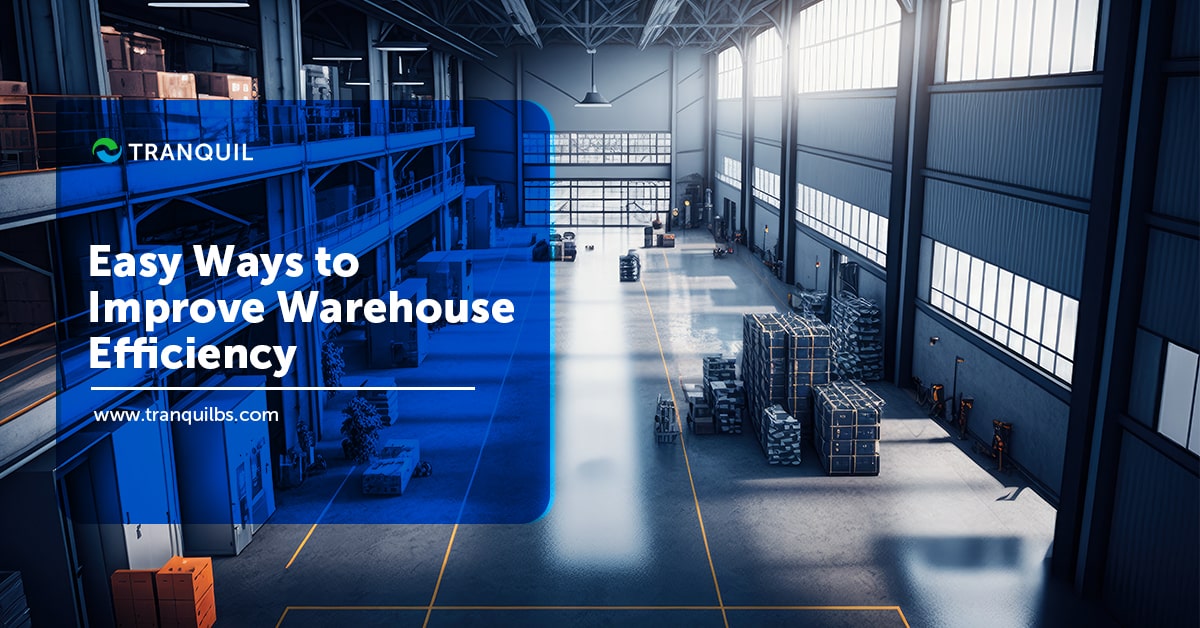
All manufacturers and most retailers have warehouses to store their products; it is essential that these warehouses are efficiently managed to ensure smooth operations.
It is only then that your employees’ safety is ensured, costs are minimized, and customer orders are shipped out and delivered in time.
A poorly managed warehouse can cause you to lose money and customers, when they don’t get orders on time.
You may also face problems like overstocking or stockouts.
So it goes without saying that optimizing your warehouse to ensure maximum efficiency is extremely important.
ALSO READ: Latest Trends in Procurement
How can you achieve this efficiency?
We have some tips for you:

A frontline manager who is able to support and encourage warehouse staff to be more productive using the right tools, feedback, and processes, is the need of the hour.
To ensure smooth warehouse operations, picking, packing, inventory management, shipment tracking, etc. have to be performed efficiently – and this calls for a reliable frontline manager.
They must also be able to recognize important areas that can be improved and prioritize worker safety above all, in the warehouse.
Obviously, good leaders are required in every workplace.
A warehouse manager not only must be very organized, they should be able to maintain their calm even in pressure cooker situations, and must continuously look for methods to improve communication and working conditions to streamline warehouse ops.
ALSO READ: Benefits of ERP- IoT Integration
You can either create efficient picking plans or use warehouse management software to generate them.
To minimize travel time, it is essential that you study material usage behavior and place the most frequently used items grouped together near the front of the warehouse.
Products that are sold together frequently should be ideally stocked near one another.
You can avoid delays in picking and streamline warehouse operations by storing the items that are picked the most in locations that are the most accessible.

You may feel that the space you have in the warehouse is not enough; warehouse expansion is an option, but an expensive one.
You need to consider if it will be worth the extra money you will spend – are your sales going to increase enough to justify the expense?
Another thing you need to consider is whether you are making the best use of the space that is available to you.
Vertical space is often not considered, but it can substantially help you to overcome space constraints.
Pallet racking is a great solution, if done right.
It must be remembered that you also have to guard against clutter and congestion – even on the outside.
For instance, you should avoid parking areas close to your entrance or exit points as this could impede speedy loading and unloading.
The inside space should be so laid out as to facilitate logical movement flow.
ALSO READ: Emerging Trends in Supply Chain Management
Following a lean inventory approach is critical for warehousing – not just manufacturing.
This means you only stock exactly what you need, and nothing extra.
You should minimize or eliminate safety stocks, and have a contract with vendors to make more frequent deliveries of smaller quantities of inventory.
Of course, to achieve this, you need to calculate how much material or product gets used every week or month, and how much time it takes for products to reach you once you have placed the order.
You will also have to consider if your product is subject to seasonal demand, and check the market trends before you set your ideal inventory levels.
When workstations are well organized, your employees can carry out tasks smoothly and quickly.
To achieve this, many warehouses follow the 5S method.
This stands for – sort, set in order, shine, standardize, sustain.
It is designed to minimize the clutter at workstations and to make them safer and more organized and workflows can be smooth.
You can also consider implementing mobile power carts and workstations, enabling employees to be nearer the activity points and minimize foot traffic for more speed and efficiency.
ALSO READ: What is Demand Forecasting?

Your storage strategy must facilitate the smooth and easy movement of forklifts to and from the warehouse.
By making separate walkways for pedestrians, you can improve warehouse safety and efficiency.
Here are some pointers for an efficient storage strategy:
It is vital that you use the correct containers to store your products; do your research and evaluate your requirements before you decide which ones you want.
They must allow easy loading of products in such a way as to make the most of the space in it.
The containers must be chosen according the products that need to be stored.
For example, medicines and medical products have regulations regarding the type of containers required for storage.
ALSO READ: What is Batch Scheduling and What are Its Benefits?
Pallets of varying strengths and durability are available in the market, and each type has its own drawbacks as well.
You can simplify the storage and transportation of goods by choosing the ideal pallets.
The most common pallet types are:
It’s also important to think about how the pallets will be used.
For instance, does your warehouse use forklifts or pallet jacks, where will they be housed – in the racks or on the ground; and whether they will be able to bear the weight of your inventory.
All these in combination must be considered to decide on the type of pallet to be used.
ALSO READ: Route and Van Sales
We have already seen how vertical space can be used by implementing tall racks and storage units.
You can also make sure you have the ideal equipment for picking and storing material and can optimize racking.
You must consider the accessibility, strength and size of the racking, and choose the most suitable types of racks.
Use flow racks for small items, and pallet or cantilever racks for big items.
It is also essential that the racking is scalable, so you should be able to enlarge them as your business grows.
This way, you can get more life out of your racks rather than replacing what you have once your needs increase.
Several types of packaging are available for use in warehouses, and you will have to compare the benefits and drawbacks of each type before purchasing any.
You will have to be especially careful about choosing the packaging material for perishable products so that they don’t get spoilt in transit.
ALSO READ: What is Negative Inventory?

From the moment a product enters the warehouse till the time it goes out, and every other movement in between, must be according to a set workflow.
In the absence of that, warehouse employees will work how it suits them – but it may not be efficient and productive from the point of view of the company.
However, when these workflows are automated, all employees can be made to work within the same guidelines.
It also becomes easy to monitor the performance of individual employees against set yardsticks for various segments.
If issues arise in fulfilment, an audit can be quickly performed to identify the bottleneck in the workflow and remedial action can be taken.
ALSO READ: What Is Cloud Data Protection?
One of the biggest issues you are likely to face with regard to warehouse efficiency is that the methods that succeeded last year may not succeed this year, and so on.
New technological advancements may also emerge, which you can leverage.
Therefore, it is essential that you continuously assess your operations and search for ways to enhance your operations.
Let’s say you want to deploy mobile workstations; however, they may not be the best suited for your warehouse.
You’ll have to go back to the drawing board and look for other options.
When you are flexible, it becomes simpler to adapt to the fluctuating market dynamics, and change your approach when what you initially planned does not work.
ALSO READ: A Guide To Inventory Stock Valuation

Warehouses are places with huge potential for injury; the rates are pretty high as compared to other workplaces.
An injury to even one employee can throw your operations into disarray, and bring down employee morale.
Therefore, it is crucial that employee safety is made a priority.
Every incident, no matter how small, must be thoroughly investigated, so that employees feel that they can point out potentially hazardous situations or equipment that they notice.
There should also be proper plans for bringing the employees back to work after they have recovered from the injury.
They can be started on light work initially, and moved to more complex and physically challenging tasks once they are fully fit.
While small warehouses can manage with manual picking, you may find this is not ideal when your business (warehouse) expands; this can hamper productivity.
With optimal picking routes, manual pickers can pick about 60 to 80 products per hour.
However, with the use of sorters, conveyors, and such automation tools, this can go up to 300 products.
Of course, you will be required to shell out a good amount of money to automate; however, the ROI delivered due to the increased productivity will make it worth it.
Inventory accuracy will be much higher, labor costs will come down, and shipping will be faster.
ALSO READ : Physical Stock Verification and Its Advantages
We live in a digital age, and technology has permeated every aspect of life.
You can increase productivity and precision in warehouses as well, with the help of technology.
This can be done by using software to manage warehouses, in addition to automation solutions.
Using AI and machine learning, you can generate optimized picking routes, minimizing travel inside the warehouse by employees.
This helps them to complete tasks faster, and with less fatigue.
How efficient your warehouse is, will have a direct impact on the efficiency of the supply chain as a whole, and of course, your revenues.
An efficiently run warehouse could mean the difference between success and failure for your business.
ALSO READ: Balance Sheet: Definition, Uses, Elements
Implementing a robust, secure, cloud-based warehouse management solution like Tranquil can help in streamlining warehouse operations for more efficiency and productivity. Tranquil has a proven track record in the GCC region in delivering excellent solutions for businesses in a wide range of industries. Schedule a FREE demo at your convenience to know more.